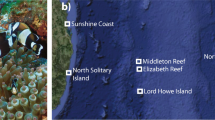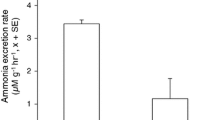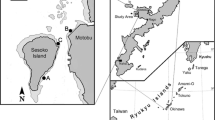Synopsis
The 25 species ofAmphiprion and one ofPremnas (family Pomacentridae) are obligate symbionts of 10 species of facultatively symbiotic sea anemones. Throughout the tropical Indo-West Pacific range of the relationship, a fish species inhabits only certain of the hosts potentially available to it. This specificity is due to the fishes. Five fishes occupy six sea anemone species at Lizard Island, Great Barrier Reef, Australia.Entacmaea quadricolor harborsP. biaculeatus, A. melanopus andA. akindynos. Adults ofPremnas occur deeper than about 3 m in large, primarily solitary actinians; juveniles may occupy peripheral members ofEntacmaea clones in shallow water. Specimens ofA. melanopus live exclusively in clonal anemones, which are found no deeper than 3 m. Most individuals ofA. akindynos inEntacmaea are juveniles, occurring shallow and deep, in solitary anemones or at the margins of clones. Interspecific as well as intraspecific social control of growth may be responsible for keeping fish small at clone fringes. Conspicuous specimens ofE. quadricolor depend upon their anemonefish to survive. Actinians cleared of symbionts disappeared within 24 h, probably having been eaten by reef fishes.Entacmaea, the most abundant and widespread host actinian at Lizard Island and throughout the range of the association, is also arguably the most attractive to anemonefishes. I believe its vulnerability to predation was a factor in its evolving whatever makes it desirable to fishes. Experimental transfers pitted fish of one species against those of another, controlling for ecophenotype of host, and sex, size and number of fish. Competitive superiority was in the same order as abundance and over-all host specificity:P. biaculeatus, A. melanopus, A. akindynos. At least three factors are necessary to explain patterns of species specificity - innate or learned host preference, competition, and stochastic processes.
Similar content being viewed by others
References cited
Allen, G.R. 1972. The anemonefishes: their classification and biology. T.F.H. Publications, Neptune City. 288 pp.
Allen, G.R. 1980. The anemonefishes of the world: species, care and breeding. Aquarium Systems, Mentor. 104 pp.
Caldwell, R.L. & H. Dingle. 1975. Ecology and evolution of agonistic behavior in stomatopods. Naturwissenschaften 62: 214–222.
Caldwell, R.L. & H. Dingle. 1979. The influence of size differential on agonistic encounters in the mantis shrimp,Gonodactylus viridis. Behaviour 69: 255–264.
Connell, J.H. 1980. Diversity and the coevolution of competitors, or the ghost of competition past. Oikos 35: 131–138.
Davenport, D. & K.S. Norris. 1958. Observations on the symbiosis of the sea anemoneStoichactis and the pomacentrid fish,Amphiprion percula. Biol. Bull. 115: 397–410.
Diamond, J.M. & M.E. Gilpin. 1982. Examination of the ‘null’ model of Connor and Simberloff for species co-occurrences on islands. Oecologia 52: 64–74.
Dingle, H., R.C. Highsmith, K.E. Evans & R.L. Caldwell. 1973. Interspecific aggressive behavior in tropical reef stomatopods and its possible ecological significance. Oecologia 13: 55–64.
Dunn, D.F. 1981. The clownfish sea anemones: Stichodactylidae (Coelenterata: Actiniaria) and other sea anemones symbiotic with pomacentrid fishes. Trans. Amer. Phil. Soc. 71: 1–115.
Eibl-Eibesfeldt, I. 1960. Beobachtungen und Versuche an Anemonenfischen (Amphiprion) der Malediven und der Nicobaren. Z. Tierpsychol. 17: 1–10.
Fautin, D.G. 1984. Competition by anemonefishes for a preferred host actinian (abstract). Amer. Zool. 24: 102A.
Fishelson, L. 1965. Observations and experiments on the Red Sea anemones and their symbiotic fishAmphiprion bicinctus. Bull. Isr. Sea Fish. Res. Sta. (Haifa) 39: 3–16.
Fricke, H.W. 1974. Öko-Ethologie des monogamen AnemonenfischesAmphiprion bicinctus (Freiwasseruntersuchung aus dem Roten Meer). Z. Tierpsychol. 36: 429–512.
Fricke, H.W. 1975. Selektives Feinderkennen bei dem AnemonenfischAmphiprion bicinctus (Rüppell). J. Exp. Mar. Biol. Ecol. 19: 1–7.
Fricke, H.W. 1979. Mating system, resource defence and sex change in the anemonefishAmphiprion akallopisos. Z. Tierpsychol. 50: 313–326.
Gilpin, M.E. & J.M. Diamond. 1982. Factors contributing to non-randomness in species co-occurrences on islands. Oecologia 52: 75–84.
Graefe, G. 1964. Zur Anemonen-Fisch-Symbiose, nach Freilanduntersuchungen bei Eilat/Rotes Meer. Z. Tierpsychol. 21: 468–485.
Herre, A.W.C.T. 1936. Some habits ofAmphiprion in relation to sea anemones. Copeia 1936: 167–168.
Kaufmann, J.H. 1983. On the definitions and functions of dominance and territoriality. Biol. Rev. 58: 1–20.
Mariscal, R.N. 1966. The symbiosis between tropical sea anemones and fishes: a review. pp. 157–171. In: R.I. Bowman (ed.) The Galapagos: Proceedings of the Symposia of the Galapagos International Scientific Project, University of California Press, Berkeley.
Mariscal, R.N. 1970. The nature of the symbiosis between Indo-Pacific anemone fishes and sea anemones. Mar. Biol. 6: 58–65.
Mariscal, R.N. 1972. Behavior of symbiotic fishes and sea anemones. pp. 327–360. In: H.E. Winn & B.L. Olla (ed.) Behavior of Marine Animals, Volume 2, Plenum Publishing Corp., New York.
Moyer, J.T. 1980. Influence of temperate waters on the behavior of the tropical anemonefishAmphiprion clarkii at Miyake-Jima, Japan. Bull. Mar. Sci. 30: 261–272.
Moyer, J.T. & L.J. Bell. 1976. Reproductive behavior of the anemonefishAmphiprion clarkii at Miyake-Jima, Japan. Jap. J. Ichthyol. 23: 23–32.
Moyer, J.T. & C.E. Sawyers. 1973. Territorial behavior of the anemonefishAmphiprion xanthurus with notes on the life history. Jap. J. Ichthyol. 20: 85–93.
Ross, R.M. 1978. Territorial behavior and ecology of the anemonefishAmphiprion melanopus on Guam. Z. Tierpsychol. 46: 71–83.
Sale, P.F. 1980. The ecology of fishes on coral reefs. Oceanogr. Mar. Biol. Ann. Rev. 18: 367–421.
Schlichter, D. 1968a. Der Nesselschutz der Anemonenfische. Verh. Deutsch. Zool. Gesell. 32: 327–333.
Schlichter, D. 1968b. Das Zusammenleben von Riffanemonen und Anemonenfischen. Z. Tierpsychol. 25: 933–954.
Verwey, J. 1930. Coral reef studies. I. The symbiosis between damselfishes and sea anemones in Batavia Bay. Treubia 12: 305–366.
Author information
Authors and Affiliations
Rights and permissions
About this article
Cite this article
Fautin, D.G. Why do anemonefishes inhabit only some host actinians?. Environ Biol Fish 15, 171–180 (1986). https://doi.org/10.1007/BF00002992
Received:
Accepted:
Published:
Issue Date:
DOI: https://doi.org/10.1007/BF00002992




